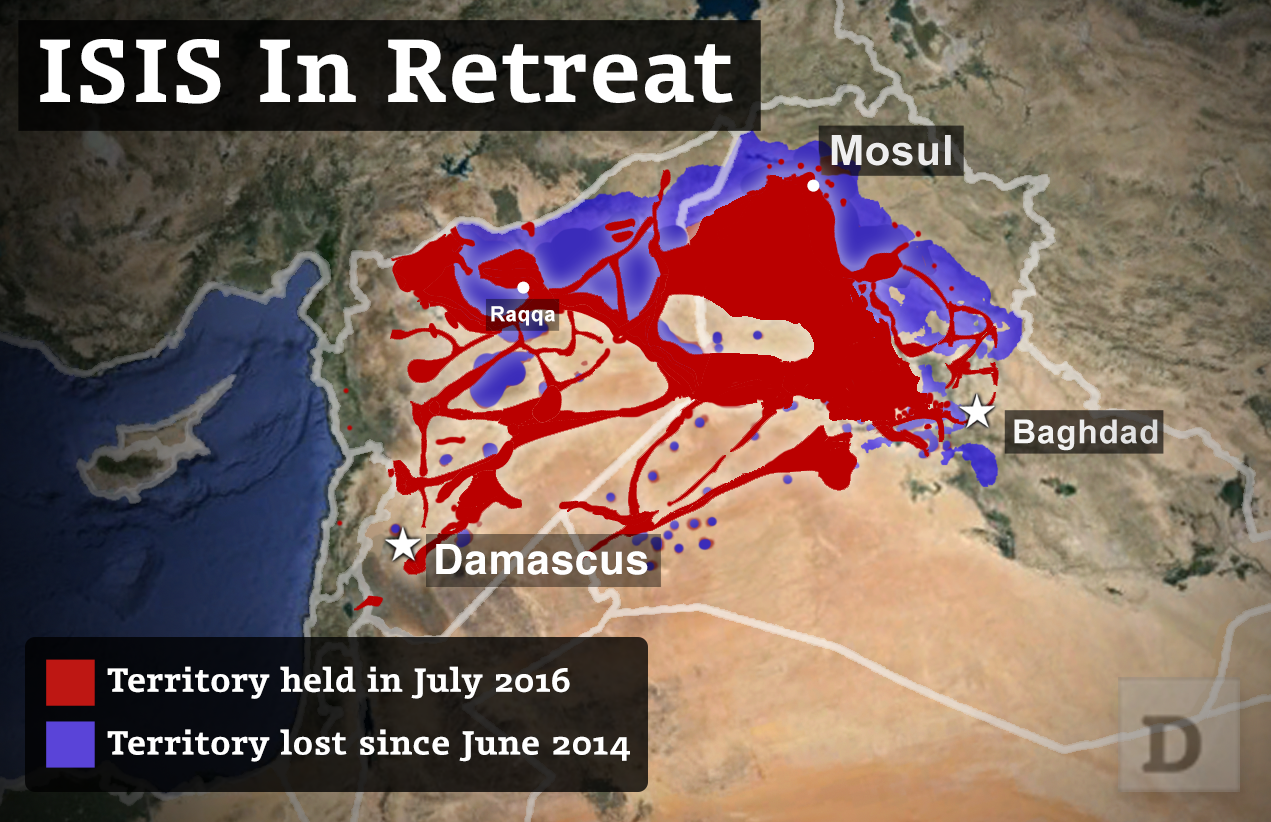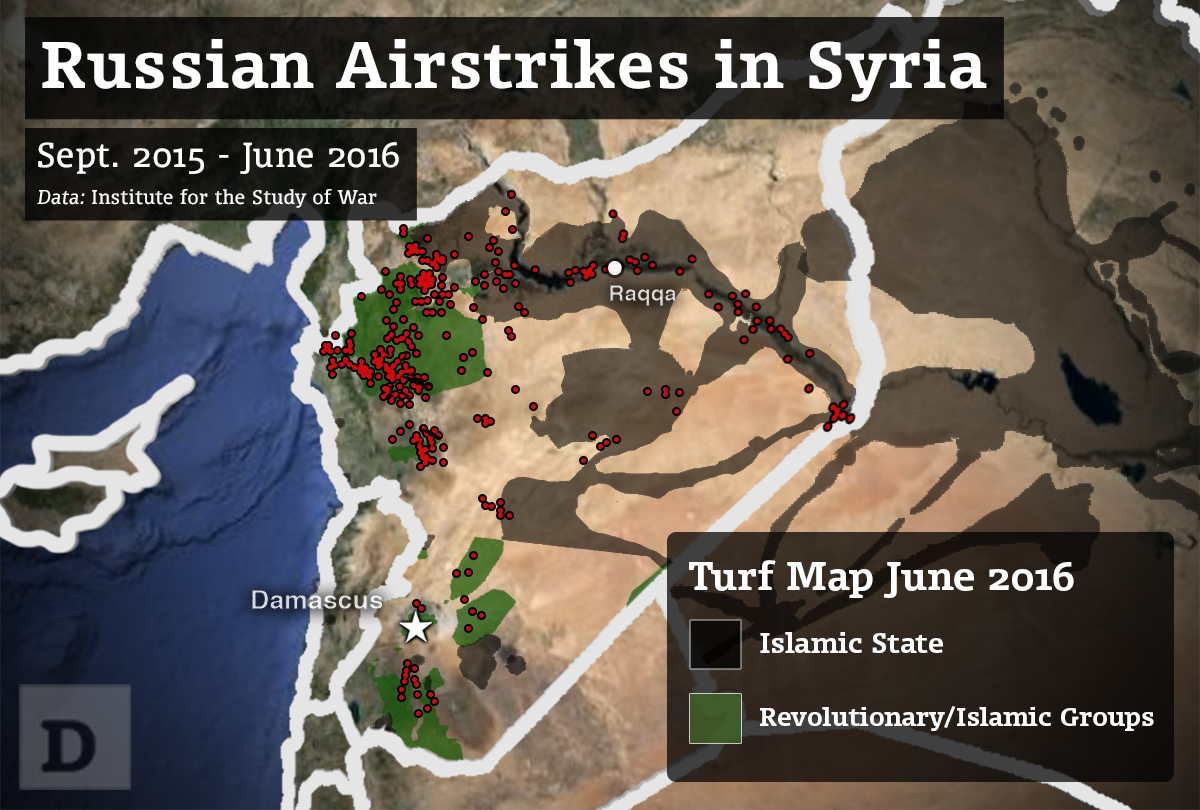Weapons of the Syrian War: Airpower (Non-Syrian)
By May 2016, the counter-ISIS coalition had dropped more than 41,500 bombs, leading the Pentagon to borrow from stockpiles in other regions.
Editor's note: This series examines 10 categories of arms used in the Syrian conflict, a ghastly proving ground for much of what 21st-century militaries and militant groups can bring to war.
First non-Syrian airstrikes in Syria: January 31, 2013 . Israeli jets penetrated Syrian air defenses, slipping into the country to strike an alleged Hezbollah weapons convoy north of Damascus.
First counter-ISIS coalition strikes in Syria: September 23, 2014 . American jets dropped munitions on elite al-Qaeda fighters in the Khorasan Group, whom administration officials said posed an imminent threat to U.S. security. The attack also included sea-launched cruise missiles. (The U.S.-led air campaign against ISIS had begun more than a month earlier. On August 8, 2014, U.S. aircraft bombed ISIS positions near Sinjar Mountain, aiming to stop an assault on Yazidi tribes from becoming a genocide.)
By May 2016, the U.S.-led counter-ISIS coalition had dropped more than 41,500 bombs, leading the Pentagon to borrow from stockpiles in other regions.
U.S. aircraft that have dropped munitions on ISIS include:
- A-10C "Warthog" close-air-support aircraft
- AH-64 Apache helicopters
- B-1B Lancer bombers
- B-52H Stratofortress bombers
- F-15C Eagle fighters
- F-16C "Viper" fighters
- F/A-18E Super Hornet strike fighters
- F-22A Raptor strike fighters
- MQ-1B Predator drones
- MQ-9A Reaper drones
- OV-10 Bronco light attack/observation planes
.png)
How much does an airstrike cost? "The cheapest possible strike could cost roughly $50,000," but that's just one jet, budgetary expert Todd Harrison, now of the Center for Strategic and International Studies, said in a 2014 interview with Foreign Policy .
Most strikes include a combination of aircraft. Consider, for example, a recent strike on an alleged convoy of ISIS fighters fleeing Fallujah: that series of strikes included 29 different aircraft.
The U.S. has spent nearly $12 million per day on the war on ISIS. Between August 2014 and May 31, 2016, the Pentagon spent $7.71 billion on the effort. (Figures last updated July 28, 2016.)
Russian aircraft include:
- Tu-160 Blackjack
- Tu-22M3
- Tu-95 Bear
- Su-24M (shot down by Turkey)
- Su-25
- Su-30SM fighter escorts
- Su-34
- Su-35
- Mi-8 search and rescue helicopter
- Mi-17 transport helicopter
- Mi-24 attack helicopter
- Mi-28NE Night Hunter
- KA-52 attack helicopter
Source: IHS ; Fox Trot Alpha ; Aviationist ; the Washington Post ; the Post again here .
And the munitions they're dropping:
- Dumb bombs: OFAB-100 and OFAB-200 anti-personnel fragmentation bombs ( Defense News )
- Smart bombs: Kh-25 laser-guided missile and the KAB-500S Glonass satellite-guided bomb, both used far less frequently than other types of munitions.
- Other: RBK-500-SPBE-D cluster bomb, ODAB-500PMB thermobaric bomb, BetAB-500 M62 penetration (or bunker-buster) bomb.
Russian Su-30 and Su-25 jets carrying out airstrikes over Syria in October 2015. // Video by state-run RT news.
The U.S. military has built up an enormous catalog of counter-ISIS airstrike imagery and videos. Other coalition nations, on the other hand, have been more reticent.
Impact of airstrikes
During the air campaign's first 10 months, ISIS continued to gain territory . But in the next eight months, U.S. military officials said, the group lost up to 45 percent of its land.
The U.S. says it has killed more than 26,000 ISIS fighters since its air campaign began in August 2014. (This claim has attracted a fair amount of criticism from experts, who note, for example, the Pentagon's June estimate that the Islamic State still had 19,000 to 25,000 fighters.) If ISIS has made one repeated demand since it executed U.S. journalist James Foley in August 2014, it has been to stop the airstrikes on its fighters. Also worth noting: a halt to the airstrikes has been a demand of the terrorists behind attacks in Brussels; Paris; Garland, Texas; and Orlando.

As for the Russian impact on the conflict, here's an excerpt from a scathing report by the Atlantic Council:
Russia carried out its air strikes with scant regard for the rules of war: Open-source footage shows the repeated use of banned cluster munitions, and strikes on targets including mosques, hospitals, and water treatment plants...
Russia’s military campaign allowed Assad’s forces to retake lost ground, a task they did with great brutality and immense human suffering. It barely dented the ISIS terrorist group, whose recent territorial losses have largely come at the hands of Kurdish militias backed by a US-led coalition. Far from shortening the war, it exacerbated it—and in so doing, it sent yet more waves of refugees flooding into Turkey and Europe.

How many Syrian civilians have died in airstrikes?
- U.S. civilian casualty count: 55. That's according to U.S. Central Command, as of July 28, 2016; critics say the actual number could be as high as 1,200.
- Russia says its planes have killed exactly zero civilians ; In March, critics said the actual number could top 2,000.
- Syrian airstrikes have reportedly killed nearly 19,000 as of September 2015.
Targeted strikes against individuals
Since January 2015, the U.S. military has used intelligence-driven strikes to target and kill "more than 120 high-value individuals in ISIL's attack network," coalition spokesman Col. Steve Warren said in May 2016.
Senior leaders and associates killed in targeted airstrikes:
- July 1, 2016: Basim Muhammad Ahmad Sultan al-Bajari , "ISIL's deputy minister of war," according to the Pentagon; and Hatim Talib al-Hamduni, "an ISIL military commander in Mosul."
- May 6, 2016: Shaker Wahib al-Fahdawi al-Dulaimi , ISIS " emir " of Iraq's Anbar province
- April 29, 2016: Neil Prakash , Australian-born ISIS recruiter killed near Mosul, Iraq.
- April 10, 2016: Fawaz al-Hassan , "extremist Sharia judge" for ISIS
- April 5, 2016: Rifai Ahmad Taha , senior Egyptian al-Qaida figure fighting in Syria; and Abu Sulayman al Belgiki , “Belgian fighter”
- April 5, 2016: Abu Omar al-Masri ,“secretive veteran jihadi and former right-hand man of Emir Khattab in Chechnya”
- April 3, 2016: Abu Firas Al Suri , spokesman for Jabhat al-Nusra
- March 25, 2016: Abd al-Rahman Mustafa al-Qaduli , “chief financier” (Note: “His death had been announced at least four times by Iraqi authorities and twice by the Americans, but this time appears more credible since some ISIL supporters began to eulogise him on social media,” according to scholar Hassan Hassan .
- March 15, 2016: Omar the Chechen ;though some indications as recent as June 20 indicate he may still be alive.
- March 15, 2016: Eidan al-Ezzi , ISIS police commander in Iraq
- March 3, 2016: Amr al Absi , Islamic State’s emir for Aleppo province
- Dec. 27, 2015: Tashin al Hayali , “external operations facilitator”
- Dec. 26, 2015: Abdul Qader Hakim , “forgery specialist” with links with Paris attackers
- Dec. 24, 2015: Charaffe al Mouadan , Syria leader “with direct link” to Paris attack planner Abdelhamid Abaaoud
- Dec. 10, 2015: Siful Haque Sujan , external operations planner and a United Kingdom-educated computer systems engineer
- Dec. 8 through 12—Abu Anas, “bomb cell facilitator”; Yunis Khalash, akaAbu Jawdat, a “deputy financial emir in Mosul”; Mithaq Najim, “deputy emir in Kirkuk province”; and Akram Muhammad Sa’ad Faris, ISIS “commander and executioner” (more here )
- Dec. 7, 2015: Rawand Dilsher Taher , “external operations facilitator”
- Dec. 7, 2015: Khalil Ahmad Ali al Wais , also known as Abu Wadhah, emir for Kirkuk province
- “Late November” 2015: Abu Saleh , finance minister; Abu Maryam , "enforcer and senior leader of extortion network"; Abu Rahman al Tunisi, a functional equivalent of an executive officer; and two other "senior extortionists," according to the U.S. military.
- Nov. 12, 2015: Mohammed Emwazi , aka “Jihadi John”
- Oct. 30, 2015: Denis Cuspert , aka “Deso Dogg,” German rapper who joined ISIS
- Sept. 10, 2015: Abu Bakr al Turkmani , “administrative emir”
- Aug. 24, 2015: Junaid Hussain, “British national involved in plotting attacks in the West”
- Aug. 21, 2015: Reyaad Khan, “British national involved in plotting attacks in the West” (both Hussain and Khan, here )
- Aug. 18, 2015: Fadhil Ahmad al Hayali (aka Hajji Mutazz, aka Abu Musallam al Turkumani), “senior deputy to ISIL leader Abu Bakr al Baghdadi”; and Abu Abdullah “an ISIL media operative”
- June 16, 2015: Tariq bin Tahar-Al-Awni-al-Harzi , a chief of foreign fighter ops and logistics
- June 15, 2015: Ali Awni al-Harzi , key link with Libyan operations
- May 17, 2015: Abu Sayyaf , (raid),“oil & gas emir” killed in Delta raid; wife captured
- May 14, 2015: Abu Alaa al-Afri, “senior ISIS deputy,” and Akram Qirbash, “senior ISIS security figure”
- May 13, 2015: Akram Qirbash , “top ISIL judge”
- Jan. 14, 2015: Hassan Saeed Al-Jabouri , also known as Abu Taluut
- “Between December 3 and December 9,” 2014: Haji Mutazz, believed killed, would actually live until August 2015; and Abd al Basit, his military emir in Iraq
- Late November 2014: Radwan Talib (aka Radwan Taleb Al-Hamdouni ), al-Baghdadi’s Mosul emir
- Nov. 7, 2014— Auf Abdulrahman Elefery , aka Abu Suja or Abu Ayman al-Iraqi, rumored to be the head of military shura
- Sept. 23, 2014: Abu Yousef al-Turki , aka “the Turk,” aka “Nusra Front leader”
Note: This list is likely missing some names; the U.S. military does not always release the names of non-"senior leaders" killed in airstrikes.
Overview | Small Arms | Tanks | Artillery | Airpower (Syrian) | Anti‑Aircraft Weapons | Barrel Bombs | Chemical Weapons | Airpower (Non‑Syrian) | Cruise Missiles | Suicide Bombers | Advisors
NEXT STORY: Weapons of the Syrian War: Cruise Missiles



